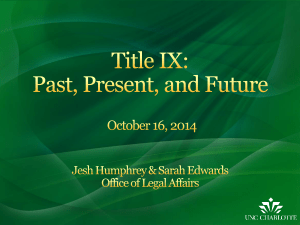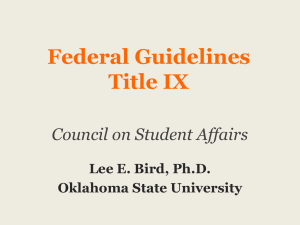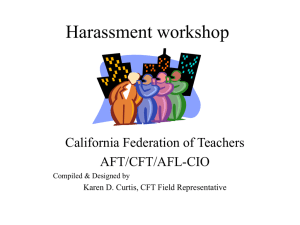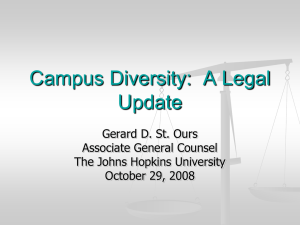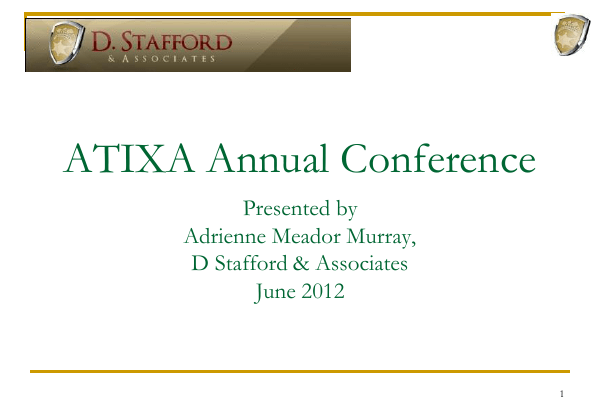
ATIXA Annual Conference
Presented by
Adrienne Meador Murray,
D Stafford & Associates
June 2012
1
Title IX
2
Regulatory Requirements - Federal
Statute
Title IX
Overview
•
20 USCA §
1681
•
•
Provides that “no person in the United States
shall, on the basis of sex, be excluded from
participation in, be denied the benefits of, or be
subjected to discrimination under any
education program or activity receiving Federal
financial assistance.” 20 U.S.C. § 1681(a).
Sexual harassment is a form of sex
“discrimination” prohibited under Title IX
Protects students from sexual harassment by
any school employee, another student or a
non-employee third party
3
What are the school’s obligations under
Title IX regarding sexual violence
Once a school knows or reasonably should
know of possible sexual violence, it must take
immediate and appropriate action to
investigate or otherwise determine what
occurred.
4
What are the school’s obligations under
Title IX regarding sexual violence
If sexual violence has occurred, a school
must:
Take prompt and effective steps to end the
sexual violence,
Prevent its recurrence, and
Address its effects,
whether or not the sexual violence is the
subject of a criminal investigation.
5
What are the school’s obligations under
Title IX regarding sexual violence
A school must take steps to protect the
complainant as necessary, including interim
steps taken prior to the final outcome of the
investigation.
6
What are the school’s obligations under
Title IX regarding sexual violence
A school must provide a grievance procedure
for students to file complaints of sex
discrimination, including complaints of sexual
violence.
7
What are the school’s obligations under
Title IX regarding sexual violence
A school’s grievance procedures must use
the preponderance of the evidence standard
(51%) to resolve complaints of sex
discrimination.
8
What are the school’s obligations under
Title IX regarding sexual violence
A school must notify both parties of the
outcome of the complaint.
9
Regulatory Requirements - Federal
Statute
Title IX
20 USCA §
1681
Overview
•
•
What is sexual harassment?
Sexual harassment is conduct that:
–
is sexual in nature;
–
is unwelcome; and
–
denies or limits (on the basis of sex) a
student’s ability to participate in or to
receive benefits, services or
opportunities in the schools program.
10
Regulatory Requirements - Federal
Statute
Title IX
20 USCA §
1681
Overview
•
Sexual harassment includes:
–
Sexual advances
–
Requests for sexual favors
–
Other verbal, nonverbal or physical
conduct of a sexual nature
–
Sexual Violence
11
Regulatory Requirements - Federal
Statute
Title IX
20 USCA §
1681
Overview
•
Sexual Violence includes:
–
Rape
–
Sexual Assault
–
Sexual Battery
–
Sexual Coercion
12
Regulatory Requirements - Federal
Statute
Title IX
20 USCA §
1681
Overview
•
Other forms of Sex Discrimination include
gender-based harassment, such as
–
–
–
Verbal, nonverbal or physical
aggression
Intimidation
Hostility based on sex or sexstereotyping
If it rises to the level that denies or limits the
student’s ability to participate in or benefit from
the educational program.
13
What is the relationship between these concepts?
Discrimination is prohibited by Title IX
Harassment is a form of
Discrimination
Sexual Harassment is a form of
Harassment
Sexual Violence is a form of
Sexual Harassment
Rape, Sexual Assault, Battery and Coercion are forms of
Sexual Violence
14
Series of Incidents versus Single Incident
The more severe the conduct, the less need
there is to show a repetitive series of
incidents to prove a hostile environment,
particularly if the harassment is physical.
A single or isolated incident may create a
hostile environment if the incident is
sufficiently severe, for example a single
incident of rape.
15
Regulations establish procedural requirements
for prevention and correction of sex discrimination
(including sexual harassment):
Issuance of a policy against sex discrimination “a notice of
nondiscrimination” (must be widely distributed)
Adoption and publication of grievance procedures
providing for prompt and equitable resolution of
complaints
Designation of a Title IX Coordinator
If discrimination occurs, the institution must take remedial
action to overcome the effects of the discrimination
Train employees
16
Training Recommendations by OCR
Train employees who have the authority to
address the harassment so they know how to
respond, i.e. Title IX Coordinators.
Train employees likely to witness or receive
reports of sexual harassment and violence,
including: teachers, law enforcement unit
employees, administrators, counselors,
general counsel employees, health personnel
and resident advisors.
17
Training Recommendations by OCR
Employees should be trained in:
What type of conduct constitutes sexual harassment.
How to identify sexual harassment and sexual
violence.
How to identify warning signals that may need
attention.
How to report sexual harassment and sexual
violence to appropriate schools officials.
18
Type of Conduct that Constitutes Sexual
Harassment: VERBAL
Whistling or making cat calls at someone
Making sexual comments about a person’s clothing or body
Telling sexual jokes or stories
Asking personal questions about sex life, fantasies ,
preferences or history
Repeatedly “asking out” a person who is not interested
19
Type of Conduct that Constitutes Sexual
Harassment: VERBAL
Turning work/class discussions to sexual topics
Telling lies or spreading rumors about a person’s personal sex
life.
Making sexual propositions, insults, or threats
Referring to an adult woman or man as a hunk, doll, babe,
honey, etc.
Calling someone by a sexually oriented demeaning name
20
Type of Conduct that Constitutes Sexual
Harassment: NON-VERBAL
Giving personal gifts of a sexual nature
Paying unwanted attention to someone, such as: staring,
following, blocking a person’s path, etc.
Making facial expressions, such as: winking, throwing kisses,
or licking
Displaying sexually suggestive visuals, such as: drawings,
pornography, screen saver, calendars, cartoons, etc.
Making sexual gestures with hands or through other body
movements
21
Type of Conduct that Constitutes Sexual
Harassment: NON-VERBAL
Content of a sexually suggestive manner in emails,
text messages, letters, notes, or Facebook
Graffiti that is of a sexual nature or sexually abusive
Looking up a skirt or down a blouse
22
Type of Conduct that Constitutes Sexual
Harassment: PHYSICAL
Hanging around, standing close, or brushing up against a
person
Touching a person’s clothing, hair or body
Massaging a person (ex. giving a neck and shoulder
massage)
Touching or rubbing oneself sexually around another person
Hugging, kissing, groping, pinching, stoking, squeezing,
tickling, fondling
23
How to Identify Sexual Harassment or
Sexual Violence and the Warning Signs
Witnessing and/or hearing any of the above
types or verbal, non-verbal and physical
conduct may lead an employee to believe
that a student may be the victim of sexual
harassment.
24
Other Warning Signs…
A student reports feeling or appears to
be feeling:
Upset
Anxious
Embarrassed
Vulnerable
Unsafe
25
Location of Allegation
The institution must investigate harassment
that occurs:
In a school’s facilities
On a school bus
At a class or training program sponsored by a school
at another location, such as a school-sponsored field
trip
26
Location of Allegation
The institution may have an obligation to respond
to student-on-student sexual harassment that
initially occurred off school, grounds, or outside a
school’s education program/activity.
If a student files a complaint with the school
Then-the school must process the complaint in
accordance with established procedures
Because—students often experience the continuing
effects of off campus harassment at school
27
Regulatory Requirements - Federal
Statute
Title IX
20 USCA §
1681
Overview
•
A school violates Title IX if it “has notice” of a
sexually hostile environment and fails to take
immediate and effective corrective action
•
A school has notice if a responsible employee knew
or, in the exercise of reasonable care, should have
known about the harassment
•
A report can be made by the student (victim);
parents or a third party.
28
Regulatory Requirements - Federal
Statute
Title IX
Overview
•
A responsible employee includes any employee
who:
–
20 USCA §
1681
–
–
•
has the authority to take action to redress the
harassment;
has the duty to report to appropriate school
officials sexual harassment or any other
misconduct by students or employees; or
a student could reasonably believe has this
authority or responsibility
Whether an employee is a responsible employee or
whether it would be reasonable for a student to
believe the employee is… will vary depending
various factors (i.e. age & educational level, position
held by employee, procedures)
29
What if the incident is reported directly to
the institution’s Law Enforcement Unit?
The law enforcement unit employees should:
Notify the complainant of their right to file a criminal
complaint
Notify the complainant of their right to file a Title IX
complaint.
LE should report incidents of sexual violence to the
Title IX coordinator if the complainant consents.
30
Conflict: “if the complainant consents” -vsthe school’s obligations under Title IX
If sexual violence has occurred, a school must:
Take prompt and effective steps to end the sexual
violence,
Prevent its recurrence, and
Address its effects,
whether or not the sexual violence is the subject of a criminal
investigation.
That said, do you have LE report the incident without
providing the victim and/or subject’s name?
31
Take prompt and effective steps to end the
sexual violence-Some Examples…
Initiate a Grievance Procedure
Initiate interim suspension of accused
Bar/PNG from campus until the investigation
and/or grievance hearing has been completed
Issue no contact order
Change academic and/or living situation
32
Prevent its recurrence-Some Examples…
Initiate interim suspension of accused
If removed from campus following grievance
procedure, permanently Bar subject from
campus
Issue no contact order
Change academic and/or living situation
Issue a warning notice to the community
33
Address its effects-Some Examples…
Provide counseling services for the victim
Provide counseling services for friends and
roommates who have been affected by the
behavior
Provide education and training programs for
entire community and/or segments of the
community.
34
How other investigations affect Title IX responsibilities
In some instances, a complainant may allege
harassing conduct that constitutes both sex
discrimination and possible criminal conduct.
Police investigations or reports may be useful
in terms of fact gathering.
35
LE Investigation
Title IX Coordinator should be given access to the
institution’s LE investigation notes and findings, if
it doesn’t compromise the investigation.
The LE investigation may be useful for factgathering, but because the standards for criminal
investigations are different, police
reports/investigations are not determinative of
whether the sexual harassment/violence violates
Title IX
36
LE Investigation
A criminal investigation does not relieve the
institution of its duty under Title IX to resolve
complaints promptly and equitably.
Institutions should not wait for the conclusion of a
criminal investigation or criminal proceeding to
begin their Title IX investigation, and if needed,
must take steps to protect the student in the
educational setting.
37
LE Investigation
Any MOU with local police must allow the institution to
meet its Title IX obligation to resolve complaints
promptly and equitably.
Although an institution may need to temporarily delay
the fact-finding portion of the Title IX investigation while
the police are gathering evidence, once notified that
the police have completed the gathering of evidence
(not the outcome of the investigation or the filing of
charges), the institution must promptly begin and
complete its fact finding for the Title IX investigation.
38
How other investigations affect Title IX responsibilities
Similarly, schools are cautioned about using the results
of insurance company investigations of sexual
harassment allegations. The purpose of an insurance
investigation is to assess liability under the insurance
policy, and the applicable standards may well be
different from those under Title IX.
In addition, a school is not relieved of its responsibility
to respond to a sexual harassment complaint filed
under its grievance procedure by the fact that a
complaint has been filed with OCR.
39
Required Actions…
Recognize and Respond to Sexual Harassment:
Quid Pro Quo Harassment = Latin term that literally
means “something for something”
-a teacher or employee conditions an educational decision
or benefit on the student’s submission to unwelcome
advances
Hostile Environment Harassment (requires further
assessment)-teachers and employees OR other students
or third parties can engage in this type of harassment.
40
OCR considers a variety of related factors to determine if a hostile
environment has been created:
OCR considers the conduct from both a subjective and
objective perspective.
In evaluating the severity and pervasiveness of the conduct,
OCR considers all relevant circumstances, i.e., “the
constellation of surrounding circumstances, expectations,
and relationships.”
Institutions should also use eight factors to evaluate conduct
in order to draw common sense distinctions between
conduct that constitutes sexual harassment and conduct that
does not rise to that level.
41
The factors…
#1:
The degree to which the conduct affected one or
more students’ education.
#2:
The type, frequency, and duration of the conduct.
#3:
The identity of and relationship between the
alleged harasser and the subject or subjects of the
harassment.
#4:
The number of individuals involved.
42
The factors…
#5:
The age and sex of the alleged harasser and the
subject or subjects of the harassment.
#6:
The size of the school, location of the incidents,
and context in which they occurred.
#7:
Other incidents at the school.
#8:
Incidents of gender-based, but nonsexual
harassment.
43
When evaluating the 8 factors…
It is the totality of the circumstances in which the
behavior occurs that is critical in determining
whether a hostile environment exists.
Consequently, in using the factors discussed
previously to evaluate incidents of alleged
harassment, it is always important to use
common sense and reasonable judgment in
determining whether a sexually hostile
environment has been created.
44
Evaluating Welcomeness
Conduct is unwelcome if the student did not request or invite
it and “regarded the conduct as undesirable or offensive.”
Acquiescence in the conduct and/or
the failure to complain
does not mean that the conduct was welcome.
For example, a student may decide not to resist sexual advances of
another student or may not file a complaint out of fear.
45
Evaluating whether harassment occurred or was welcome…
The investigation should include an assessment of the following:
Statements by any witnesses to the alleged incident
Evidence about the relative credibility of the allegedly harassed
student and the alleged harasser.
Evidence that the alleged harasser has been found to have
harassed others may support the credibility of the student claiming
the harassment
Evidence of the allegedly harassed student’s reaction or behavior
after the alleged harassment
Evidence about whether the student claiming harassment filed a
complaint or took other action to protest the conduct soon after the
alleged incident occurred.
Other contemporaneous evidence.
46
Steps an institution should take…
Regardless of whether a formal complaint was filed, promptly
initiate an investigation to determine what occurred and take
steps to resolve the situation.
Consider taking interim measures during the investigation, if deemed
necessary to, protect the complainant from further harassment and prevent
retaliation.
In addition, by investigating the complaint to the extent
possible –– including by reporting it to the Title IX
coordinator–– the school may learn about or be able to
confirm a pattern of harassment based on claims by different
students that they were harassed by the same individual.
47
What if the victim wants the complaint to remain confidential?
The school should inform the student that a confidentiality
request may limit the school’s ability to respond.
The school also should tell the student that Title IX prohibits
retaliation and that, if he or she is afraid of reprisals from the
alleged harasser, the school will take steps to prevent
retaliation and will take strong responsive actions if
retaliation occurs.
If the student continues to ask that his or her name not be
revealed, the school should take all reasonable steps to
investigate and respond to the complaint consistent with the
student’s request as long as doing so does not prevent the
school from responding effectively to the harassment and
preventing harassment of other students.
48
What if the victim wants the complaint to remain confidential?
OCR enforces Title IX consistent with the federally protected due
process rights of students and employees. Thus, for example, if
a student, who was the only student harassed, insists that his or
her name not be revealed, and the alleged harasser could not
respond to the charges of sexual harassment without that
information, in evaluating the school’s response, OCR would not
expect disciplinary action against an alleged harasser.
At the same time, a school should evaluate the confidentiality
request in the context of its responsibility to provide a safe and
nondiscriminatory environment for all students.
49
What if the victim wants the complaint to remain confidential?
The school may weigh the request for confidentiality
against the following factors:
the seriousness of the alleged harassment
the age of the student harassed
whether there have been other complaints or reports of
harassment against the alleged harasser
and the rights of the accused individual to receive information
about the accuser and the allegations if a formal proceeding
with sanctions may result.
The school should inform the complainant if it cannot ensure
confidentiality.
50
What if the victim wants the complaint to remain confidential?
Although a student’s request to have his or her name withheld may
limit the school’s ability to respond fully to an individual complaint of
harassment, other means may be available to address the
harassment.
There are steps a recipient can take to limit the effects of the
alleged harassment and prevent its recurrence without initiating
formal action against the alleged harasser or revealing the identity
of the complainant.
Examples include
conducting sexual harassment training for the school site or academic department
where the problem occurred;
taking a student survey concerning any problems with harassment, or
implementing other systemic measures at the site or department where the alleged
harassment has occurred.
51
Equitable Grievance Procedures
As part of the grievance procedures,
institutions conduct investigations and
hearings.
During the investigation and hearing:
Parties must have an equal opportunity to present
relevant witnesses and other evidence.
Both must be afforded similar and timely access to
information that will be used in the hearing.
If lawyers are permitted, both parties can have them.
52
Equitable Grievance Procedures
OCR discourages schools from allowing the
parties to personally question or crossexamine each other during a hearing.
OCR recommends the institutions provide an
appeals process. If an appeals process is
provided, it must do so for both parties.
Institutions must maintain documentation of
all proceedings, including: written findings of
facts, transcripts, or audio recordings.
53
Equitable Grievance Procedures
•
OCR will evaluate time frames for all major
stages of the procedures as well as the process
for extending timelines. Specify:
Time frame for conducting full investigation
– Time frame for both parties to receive a response
regarding the outcome of the complaint (send concurrently)
– Time frame for filing an appeal
Both parties should be given periodic status updates.
OCR experience: typical investigation takes 60 calendar
days.
–
54
Remedies that OCR would seek
Remedies for the Complainant
Remedies for the broader student population
Development of Materials and
Implementation of Policies and Procedures
Detailed in the April 4, 2011 OCR Dear Colleague Letter
55
Remedies for the Complainant
Examples:
Academic remedies—
Allow the student to withdraw from a class with no
penalty
Allow a student to re-take the classes she failed for
the semester at no cost
If a student was the victim of retaliation by a
professor and was given a lower grade than she
deserved, provide a review to give her the grade she
earned.
56
Remedies for the broader student
population
Examples:
Provide Education Programs
Notify campus population about the how to file a
sexual harassment complaint
Provide campus community with information about
Title IX Rights and Resources
57
Office of Civil Rights and Sexual Misconduct
A recent OCR investigation revealed that:
The college had three differing grievance procedures for
addressing sexual harassment.
Several sexual misconduct incidents were handled criminally but
not addressed as sexual harassment pursuant to Title IX.
Sexual harassment complaints were handled through the
college’s judicial system, but the judicial system was inconsistent
with the college’s obligations under Title IX.
Staff training on the requirements of Title IX was insufficient.
58
Office of Civil Rights and Sexual Misconduct
The Voluntary Resolution Agreement
Requires remedial measures in:
Title IX procedural requirements
Training
Student-focused remedies
Reporting/implementation.
College required to conduct “climate checks” of student body at end
of next three school years to gauge effectiveness of remedial
measures.
59
Office of Civil Rights and Sexual Misconduct
The Voluntary Resolution Agreement
Title IX Coordinator must review campus police records for violations
of Title IX and respond.
College must coordinate with local law enforcement to ensure Title IX
compliance in instances of reported criminal conduct. College must,
at very least, provide witnesses with Title IX rights and resources and
take any necessary steps to ensure their safety and safety of campus
community.
60
OCR considers a number of factors in evaluating whether
an institution’s grievance procedures are prompt and
equitable…
Notice of procedures provided to students and employees,
including where to file a complaint.
Application of their specific procedures to complaints of sexual
harassment filed by employees, students and third parties.
Adequate, reliable and impartial investigation of complaints,
including the opportunity to present witnesses and other
evidence.
61
OCR considers a number of factors in evaluating whether
an institution’s grievance procedures are prompt and
equitable…
Designated and reasonably prompt timeframes for major stages
of the complaint process.
Notice to the parties of the outcome of the complaint
An assurance that reasonable steps will be taken to prevent
recurrence of any harassment and to correct its discriminatory
effects.
62
Notice to Students & Employees
Send out Annually—In Annual Security Report?
The Title IX Coordinator for the Institution is
POSITION(S). He/she is located in BUILDING
NAME/ADDRESS and can be reached at PHONE
NUMBER.
The institution has adopted and published grievance
procedures providing for prompt and equitable resolution
of student and employee complaints alleging any action
that would be prohibited by Title IX, including sexual
harassment and sexual assaults carried out by
employees, other students or third parties. This
information can be found at: DIRECT LINK.
63
Notice to Students & Employees
Send out Annually
Further, Title IX regulations require the institution to notify
the campus community that it does not discriminate on the
basis of sex in educational programs or activities that the
institution operates and that the institution is required by
Title IX not to discriminate in such a manner.
64
The Clery Act
65
2008 HEOA added this procedure to the Program
Participation Agreement
It applies to applicable disciplinary proceedings that your institution
conducted on or after 8/14/09.
In your Annual Security Report, you must provide a policy statement
about the following:
The institution will, upon written request, disclose to the alleged victim
of a crime of violence or a non-forcible sex offense, the report on
the results of any disciplinary proceeding conducted by the
institution against a student who is the alleged perpetrator of such
crime or offense.
If the alleged victim is deceased as a result of such crime or offense,
the next of kin of such victim shall be treated as the alleged victim
for purposes of this paragraph.
66
Sex Offense Policy and Procedures
Change of academic and living situation if requested and
reasonably available
Procedures for campus disciplinary action
Accuser/accused must have same opportunities to have
others present
Unconditionally informed of outcome of disciplinary
proceedings
List of sanctions that may be imposed following a final
determination
Advisor, Lawyer, Witnesses
67
2008 HEOA added this procedure to the
Program Participation Agreement
According to Section 16 of title 18 of the United States
Code, the term “crime of violence” means—
(a) an offense that has as an element the use, attempted use, or
threatened use of physical force against the person or property of
another, or
(b) any other offense that is a felony and that, by its nature, involves
a substantial risk that physical force against the person or property
of another may be used in the course of committing the offense.
The results of a disciplinary proceeding means--only
the institution’s final determination with respect to the
alleged sex offense and any sanction that is imposed
against the accused.
68
Sex Offense Programs
Description of educational programs that
are designed to promote the awareness of
rape,
acquaintance rape and
other forcible and non-forcible sex offenses.
69
Sex Offense Policy and Procedures
Procedures to follow when a sex offense occurs:
Importance of preserving evidence
Whom an alleged offense should be reported
Option to notify appropriate law enforcement authorities:
On-campus and local police
Statement that institutional personnel will assist the student in
notifying these authorities
70
Sex Offense Policy and Procedures
Notification of existing on/off campus
services to include:
Counseling and other mental health centers
Rape/sexual assault crisis centers
On campus advocacy centers
71
Campus SaVE Act
Campus Sexual Violence Elimination Act (S.
834/H.R. 2016)
As introduced in the spring of 2011 by U.S.
Senator Bob Casey and Representative
Carolyn Maloney, this Act is intended to
complement the new Title IX Guidance by the
U.S. Department of Education’s Office for Civil
Rights.
© All rights reserved
72
The Campus SaVE Act (S.834/H.R. 2016)
will attempt to:
(1) update the Jeanne Clery Act to
acknowledge the spectrum of sexual violence
affecting students on campus, which includes
domestic violence, dating violence and stalking
(2) it establishes minimum standards for
campus judicial proceedings consistent with
new Title IX guidance released by the
Department of Education’s Office for Civil
Rights.
© All rights reserved
73




